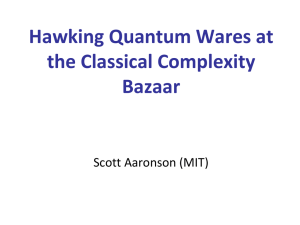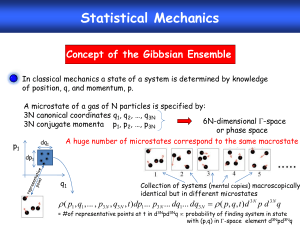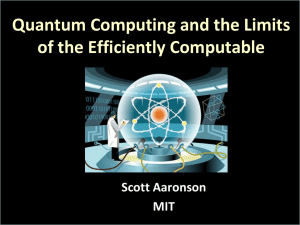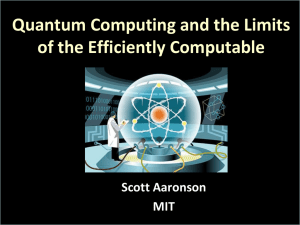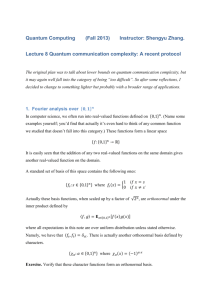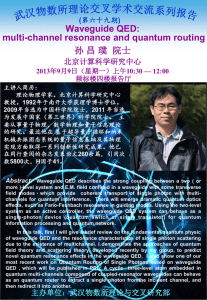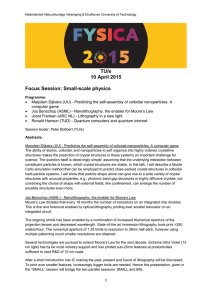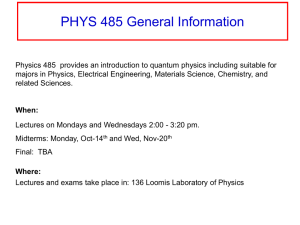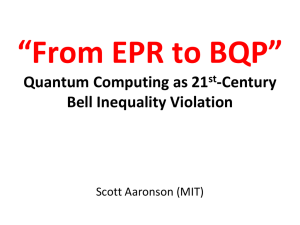Forrelation - Scott Aaronson
advertisement
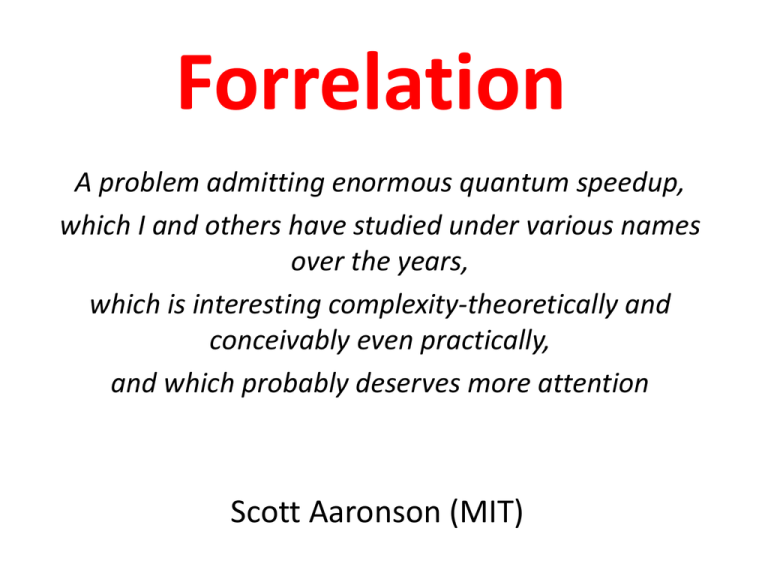
Forrelation
A problem admitting enormous quantum speedup,
which I and others have studied under various names
over the years,
which is interesting complexity-theoretically and
conceivably even practically,
and which probably deserves more attention
Scott Aaronson (MIT)
The Problem
Given oracle access to two Boolean functions
f , g : 0 ,1 1,1
n
Decide whether
(i) f,g are drawn from the uniform distribution U, or
(ii) f,g are drawn from the “forrelated” distribution: pick a
n
2
random unit vector v , then let
f x : sgn v x , g x : sgn vˆ x
vˆ x :
1
2
n
1
y 0 ,1
n
x y
vy
f(0000)=-1
f(0001)=+1
f(0010)=+1
f(0011)=+1
f(0100)=-1
f(0101)=+1
f(0110)=+1
f(0111)=-1
f(1000)=+1
f(1001)=-1
f(1010)=+1
f(1011)=-1
f(1100)=+1
f(1101)=-1
f(1110)=-1
f(1111)=+1
Example
g(0000)=+1
g(0001)=+1
g(0010)=-1
g(0011)=-1
g(0100)=+1
g(0101)=+1
g(0110)=-1
g(0111)=-1
g(1000)=+1
g(1001)=-1
g(1010)=-1
g(1011)=-1
g(1100)=+1
g(1101)=-1
g(1110)=-1
g(1111)=+1
Trivial Quantum Algorithm!
|0
H
|0
H
|0
H
H
f
H
H
g
H
H
H
Probability of observing |0n:
2
n
2
1
x y
f
x
1
g
y
3n
2 x , y 0 ,1n
1
if
f,g are random
if
f,g are forrelated
Can even reduce from 2 queries to 1 using
standard tricks
Classical Complexity of Forrelation
A. 2009: Classically, Ω(2n/4) queries are needed to decide
whether f and g are random or forrelated
Ambainis 2011: Improved to Ω(2n/2/n)
Ambainis 2010: Any problem whatsoever that has a 1query quantum algorithm—or more generally, is
represented by a degree-2 polynomial—can also be
solved using O(N) classical randomized queries
N = total # of input bits (2n in this case)
Putting Together: Among all partial Boolean functions
computable with 1 quantum query, Forrelation is almost
the hardest possible one classically!
de Beaudrap et al. 2000: Similar result but for
nonstandard query model
My Original Motivation for Forrelation
Candidate for an oracle separation between BQP and PH
Conjecture: No constant-depth circuit with 2poly(n) gates
can tell whether f,g are random or forrelated
A. 2009: For every conjunction C of f- and g-values,
Pr f , g forrelated
2
C
1
| C
O
2n/2
2
I conjectured that this, by itself, implied the requisite
circuit lower bound. (“Generalized Linial-Nisan
Conjecture”) Alas, turned out to be false (A. 2011)
Still, the GLN might hold for depth-2 circuits
And in any case, Forrelation shouldn’t be in PH!
Different Motivation
This is another exponential quantum speedup!
Challenge: Can we find any “practical” application for it?
I.e., is there any real situation where Boolean functions
f,g arise that are forrelated, but non-obviously so?
Related Challenge: Is there any way (even a contrived
one) to give someone polynomial-size circuits for f and g,
so that deciding whether f and g are forrelated is a
classically intractable problem?
k-Fold Forrelation
Given k Boolean functions f1,…,fk:{0,1}n{1,-1}, estimate
to additive error 2(k+1)n/2
Once again, there’s a trivial k-query quantum algorithm!
|0
H
|0
H
|0
H
H
H
f1
H
H
Can be improved to k/2 queries
fk
H
H
Classical Query Complexity
Ambainis 2011: Any problem whatsoever that has a kquery quantum algorithm—or more generally, is
represented by a degree-2k polynomial—can also be
solved using O(N1-1/2k) classical randomized queries
Conjecture: k-fold forrelation requires Ω(N1-1/2k)
randomized queries, where N=2n
If the conjecture holds, k-fold forrelation yields all largest
possible separations between quantum and randomized
query complexities: 1 vs. Ω(N) up to log(N) vs. Ω(N)
Right now, we only have the Ω(N / log N) lower bound from
restricting to k=2
k-fold Forrelation is BQP-complete
|0
H
|0
H
|0
H
H
H
f1
fk
H
H
H
H
Starting Point: Hadamard + Controlled-Controlled-SIGN
is a universal gate set
Issue: Hadamards are constantly getting applied even
when you don’t want them!
Solution:
H
H
C
P
H
A
S
E
3
S
W
A
P
Want to explain QC to a classical
math/CS person?
What a quantum computer can do, is estimate sums of
this form to within 2(k+1)n/2 , for k=poly(n):
“Most self-contained” PromiseBQP-complete problem
yet? Look ma, no knots!
k=polylog(n) PromiseBQNC-complete problem
Fourier Sampling Problem
n
Given a Boolean function f : 0 ,1 1,1
output
z{0,1}n
2
ˆ
with probability f z
Trivial Quantum Algorithm:
|0
H
|0
H
|0
H
H
f
H
H
Also a search version:
“Find z’s that mostly
have large values of
ˆf z 2 "
A. 2009: If f is a random
black-box function, then
the search problem isn’t
f
PH
even in FBPP !
Bremner and Shepherd’s IQP Idea
arxiv:0809:0847
Fourier Sampling oracle
Classical verifier
Obfuscated circuit
for f
Samples from f’s
Fourier distribution
“Yes, those samples
are good!”
Bremner and Shepherd propose
a way to do this. Please look at
their scheme and try to evaluate
its security!
Instantiating Simon’s Black Box?
Given: A degree-d polynomial p : F
n
q
Fq
specified by its O(nd) coefficients
Goal: Find the smallest k such that p(x) can be rewritten
as r(Ax), where r is another degree-d polynomial and
kn
A Fq
This problem is easily solved in quantum polynomial
time, by Fourier sampling! (Indeed, ker A is just an
abelian hidden subgroup)
Alas: By looking at the partial derivatives of p, it’s also
solvable in classical polynomial time—at least when d<q
Summary
Forrelation: A problem that QCs can solve in 1 query, and
that’s “maximally classically hard” among such problems
k-Fold Forrelation: A problem that QCs can solve in k
queries, that we think is maximally classically hard
among such problems, and that captures the power of
BQP (when k=poly(n)) or BQNC (when k=polylog(n))
Fourier Sampling: A sampling problem, closely related to
Bremner/Shepherd’s IQP (and to Simon’s algorithm), that
yields extremely strong results about the power of QC
relative to an oracle. Maybe even in the “real” world?

